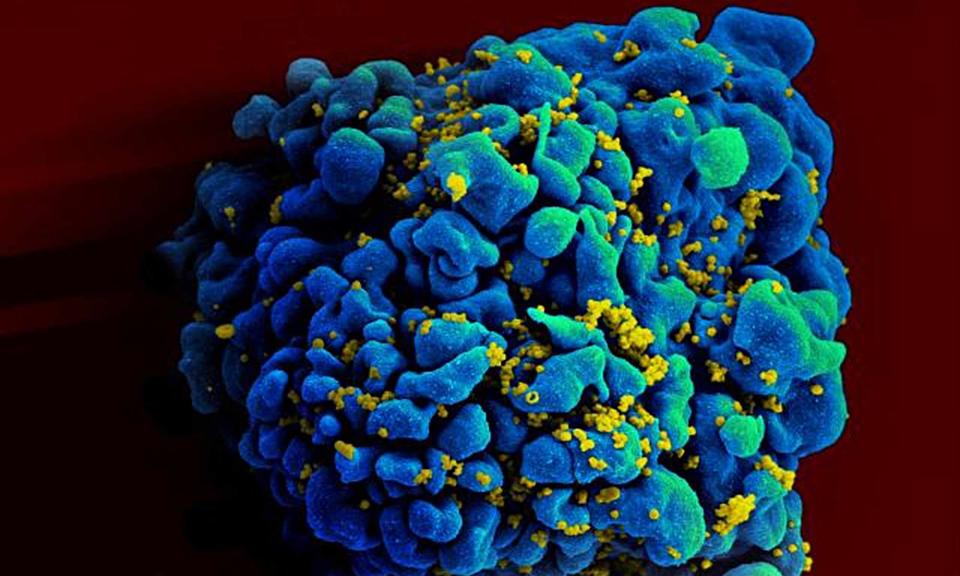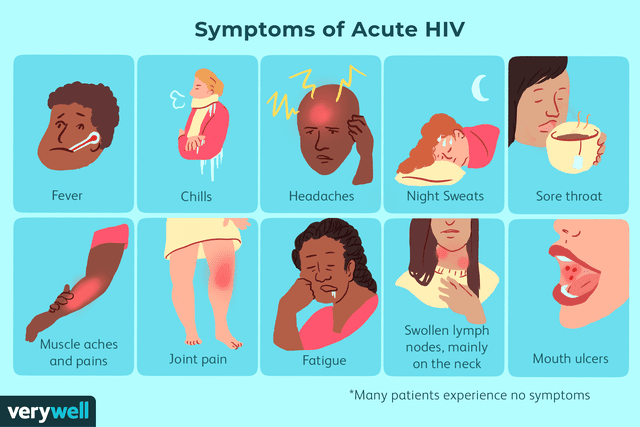HIV Symptoms
Stages of HIV and Related Symptoms

Medically reviewed by Ronald Lubelchek, MD
This article is part of Health Divide: HIV, a destination in our Health Divide series.
HIV symptoms vary by stage of infection. There are three stages: primary infection (Stage 1), clinical latency (Stage 2), and AIDS (Stage 3).
During primary infection, the symptoms are caused by the virus itself and may include fever, fatigue, swollen lymph nodes, and rash.
During the last stage, symptoms are mainly the result of opportunistic infections (OIs) that occur when HIV progressively destroys the immune system. As a result, the symptoms can vary based on the type of OI you get as well as its location (such as the eyes, lungs, or brain).
This article describes the possible signs and symptoms of HIV at the different stages of infection. It also explains why different groups are more likely to experience symptoms of AIDS than others.

Verywell / Colleen Tighe
HIV disproportionately affects people of color in the United States. Because they are less likely to receive HIV-specific care, Black people with HIV are at an eight-fold greater risk of death than White people with HIV. This is despite the fact that Black people are no less likely to be diagnosed during later-stage infection than White people.
Related:How Is HIV Diagnosed?
Stage 1: Primary Infection
Primary infection is when HIV enters the body and the immune system launches its frontline defense. Also known as acute seroconversion or acute retroviral syndrome (ARS), this is the stage where the body tries to control the infection.
During this stage, the immune system releases chemicals that trigger inflammation throughout the body. While this helps clear the circulating virus, it can also cause symptoms similar to the flu as the body develops high levels of inflammation.
Not everyone who gets HIV develops symptoms during primary infection. Those who do generally do so within two to four weeks of exposure to the virus.
Symptoms can include:
Fever
Chills
Headache
Sore throat
Fatigue
Joint pain
Mouth ulcers
One in five people may also develop an "HIV rash." The rash is characterized by raised, reddened areas of skin covered with small, pimple-like bumps. The rash most often affects the upper body and may be accompanied by mouth or genital ulcers.
Primary infection can last for around two to four weeks, after which symptoms will clear as the body brings the infection under control. The virus is not gone but instead moves into the next phase known as clinical latency.
Black people and men who have sex with men (MSM) account for the lion's share of new HIV infections in the United States. Roughly 30% of all new cases are among Black MSM who have no less than a 50/50 chance of getting HIV in their lifetime. Black transgender people are also at risk, particularly Black trans women of whom 62% are living with HIV.
Causes for this disparity include stigma, racism, higher rates of poverty, lack of access to quality healthcare, and distrust in public health institutions.
Related:Uncommon Early Symptoms of HIV
Stage 2: Clinical Latency
Clinical latency is when the initial symptoms have cleared, but the infection persists at lower levels. The infection is no longer considered acute (meaning severe and sudden) but is now regarded as chronic (meaning persistent).
During clinical latency, the virus will evade immune detection by hiding itself in tissues throughout the body known as "viral reservoirs." Those that remain in circulation will continue to target and kill immune cells known as CD4 T-cells that are responsible for "signaling the alarms" whenever there is an infection.
As more and more of these cells are picked off, the CD4 count (which measures the number of CD4 T-cells in a cubic millimeter of blood) can drop beneath normal levels of 500 to 1,500 and leave the body less and less able to recognize and fight infections.
The depletion of CD4 T-cells is a gradual process that often takes years before a serious illness occurs. Even so, a person may develop certain non-specific symptoms as the immune system is progressively weakened.
These include:
Persistent fatigue
Swollen lymph nodes (HIV lymphadenopathy)
Chronic diarrhea (HIV-associated diarrhea)
Patchy, red, dry skin (seborrheic dermatitis)
White lesions on the tongue or cheeks (oral thrush)
Recurrent respiratory infections (including bacterial pneumonia)
Recurrent mouths sores
Unexplained weight loss
An outbreak of genital herpes is also common during the chronic stage and is often the first thing that leads a person to seek a diagnosis of HIV.
Other people may experience an outbreak of shingles years before people in the general population do (typically 60 and over).
Without treatment, the chronic phase of HIV can last for around 10 years, during which there may be few notable symptoms. It is only when the immune system is compromised that a person is said to have AIDS.
People with HIV assigned female at birth may experience recurrent yeast infections, pelvic inflammatory disease (PID), irregular periods, early menopause, and a higher risk of osteoporosis and cervical cancer, than those without HIV.
People with HIV assigned male at birth may be at higher risk of erectile dysfunction, gynecomastia (abnormal breast growth), infertility, and anal and penile cancer than those without HIV.

Verywell / Julie Bang
HIV Progression
The progression of HIV is not the same for all people. For some, the period of clinical latency may only last for two years. Although there are many reasons for this, including a person's genetics and the type of HIV they have, social factors like poverty and the lack of insurance also play a part.
Studies have shown that low socioeconomic status is associated with poorer immune status in people with HIV (as measured by the CD4 count). A low CD4 count at the time of exposure is, in turn, associated with faster disease progression.
According to the CDC, the rate of poverty among people living with HIV in urban Latinx and Black communities is four and 19 times greater, respectively, than their White counterparts. This translates to faster disease progression and poorer survival times in people of color.
Related:How Do HIV Symptoms Differ in Women?
Stage 3: AIDS
AIDS (acquired immune deficiency syndrome) is the most advanced stage of HIV where the immune system has been fully compromised. This leads to an ever-widening range of OIs with serious and often life-threatening complications.
AIDS is defined by the Centers for Disease Control and Prevention (CDC) as having either:
A CD4 count of under 200 (meaning that you are immunocompromised)
ORAn AIDS-defining condition (one of over 28 illnesses rarely seen outside of people with AIDS)
Symptoms at this stage are primarily related to the type of OI a person gets. There are a handful of exceptions such as AIDS dementia and HIV wasting syndrome, both of which are thought to be caused by the virus.
The symptoms of AIDS can be characterized by the organ systems affected by the AIDS-defining condition:
Organ System | Possible Symptoms |
Brain | - Painful headaches |
Eyes | - Persistent eye dryness |
Gastrointestinal | - Mouth and throat sores |
Liver | - Upper abdominal pain |
Lungs | - Shortness of breath |
Skin | - Painless bruise-like lesions |
Due to health inequities and other vulnerabilities, Black people with HIV are more than 10 times more likely to progress to AIDS than White people with HIV and three times more likely than Latinx people with HIV.
Related:How Long Does It Take for HIV to Become AIDS?
Summary
HIV has three three stages: primary, clinical latency, and AIDS. Symptoms can vary between stages.
People in the primary stage of HIV may experience flu-like symptoms between two and four weeks after exposure. These symptoms may last up to four weeks.
People in the latent stage may experience more general symptoms such as fatigue, swollen lymph nodes, and recurrent respiratory infections.
When the condition progresses to AIDS, symptoms will depend on the type of opportunistic infections a person has. These infections can infect multiple body systems including the brain, eyes, internal organs, and skin.

